PSYC224: Organizational Behavior Analysis of Cineplex Report
VerifiedAdded on 2023/01/16
|10
|2127
|23
Report
AI Summary
This report provides a detailed analysis of Cineplex's organizational behavior, examining key aspects such as power dynamics, leadership styles (including participative and transformational leadership), organizational culture (clan-oriented), organizational structure (mechanistic), and historical changes (merger/acquisition). The report explores various influencing tactics, decision-making practices, and the impact of globalization, including ethnocentric tendencies and diversity management. It also covers employee empowerment, socialization, and strategies for handling organizational stress and resistance to change. The analysis utilizes several academic sources to support the findings and provides a comprehensive overview of Cineplex's internal operations and its response to external influences.
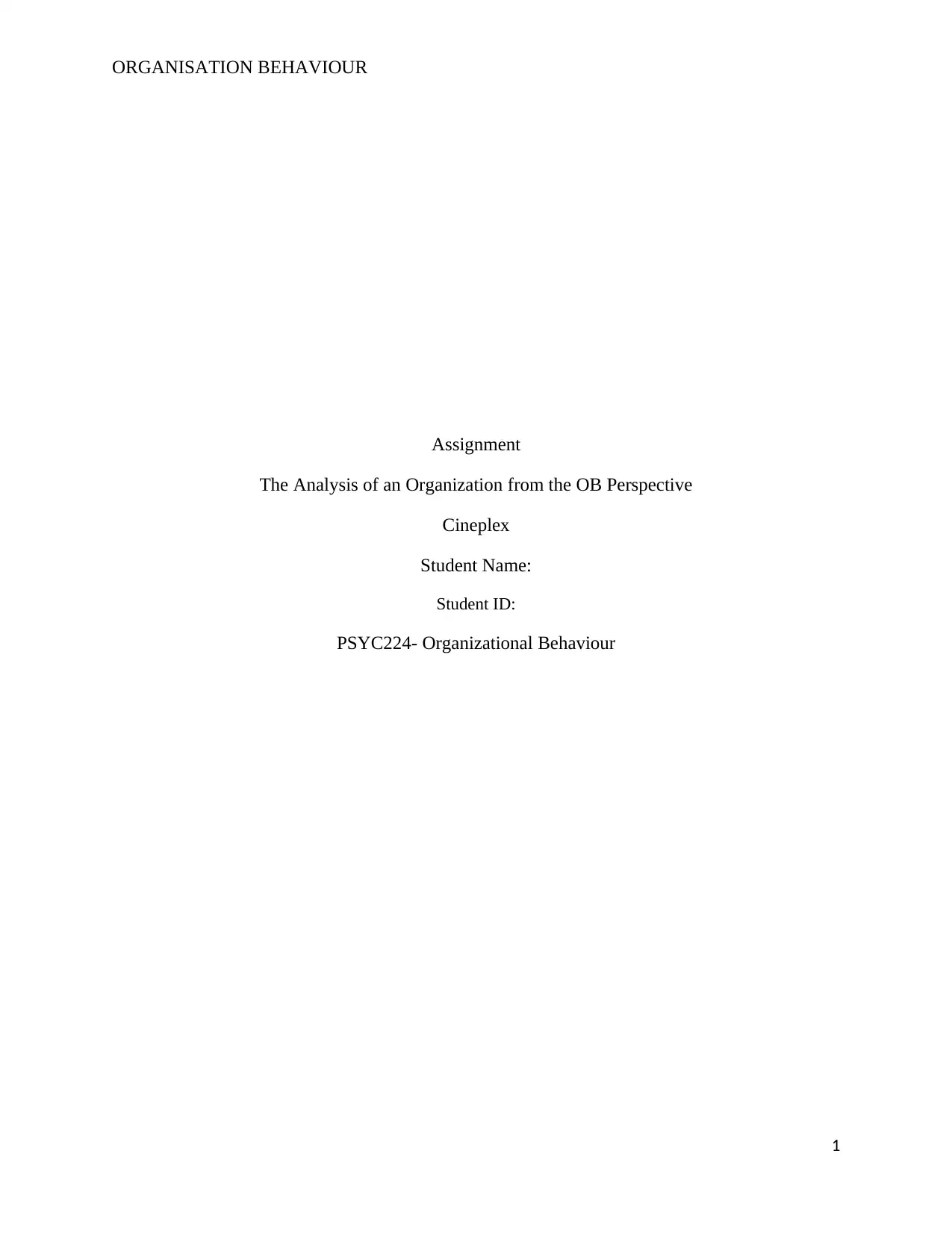
ORGANISATION BEHAVIOUR
Assignment
The Analysis of an Organization from the OB Perspective
Cineplex
Student Name:
Student ID:
PSYC224- Organizational Behaviour
1
Assignment
The Analysis of an Organization from the OB Perspective
Cineplex
Student Name:
Student ID:
PSYC224- Organizational Behaviour
1
Paraphrase This Document
Need a fresh take? Get an instant paraphrase of this document with our AI Paraphraser
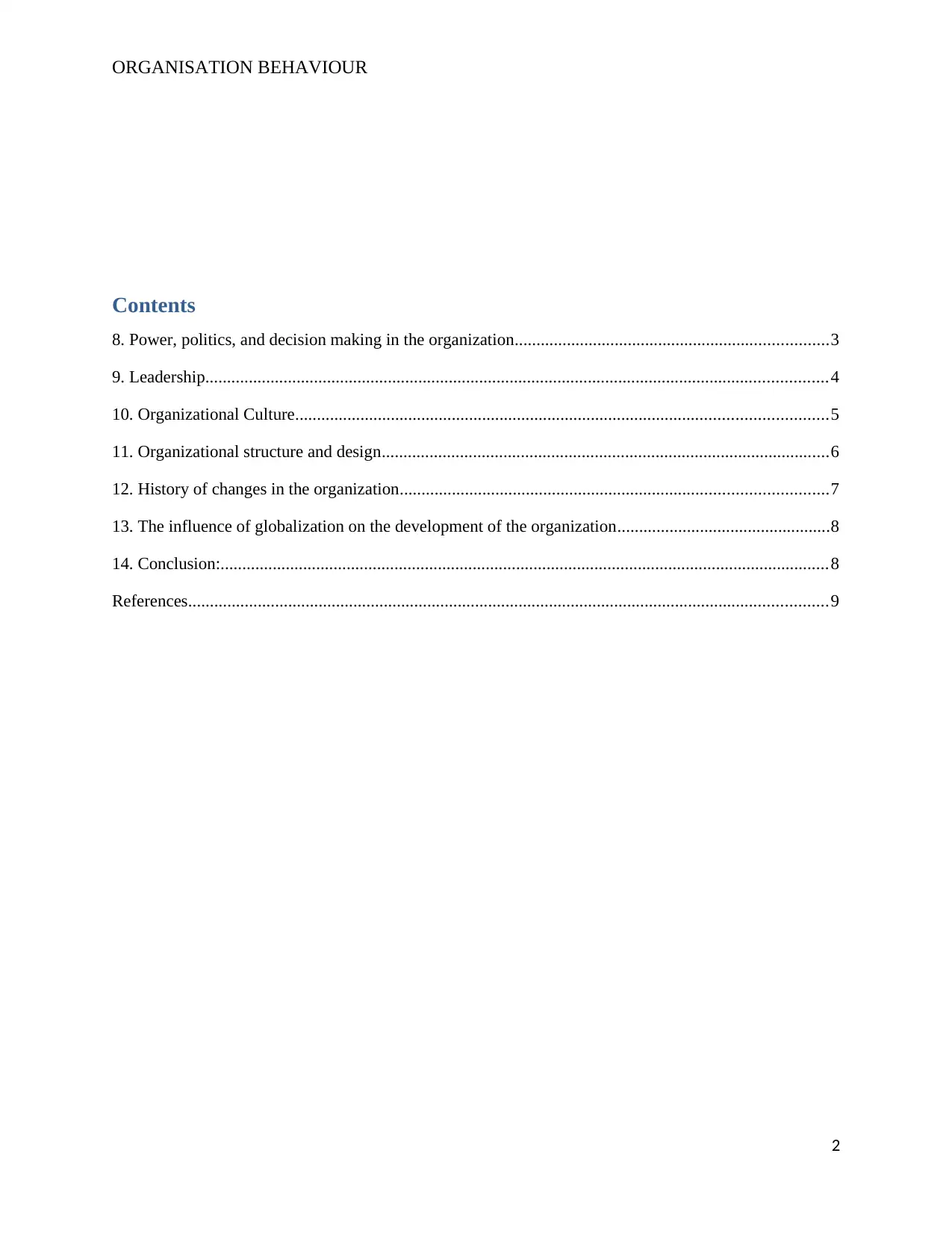
ORGANISATION BEHAVIOUR
Contents
8. Power, politics, and decision making in the organization........................................................................3
9. Leadership...............................................................................................................................................4
10. Organizational Culture..........................................................................................................................5
11. Organizational structure and design.......................................................................................................6
12. History of changes in the organization..................................................................................................7
13. The influence of globalization on the development of the organization.................................................8
14. Conclusion:............................................................................................................................................8
References...................................................................................................................................................9
2
Contents
8. Power, politics, and decision making in the organization........................................................................3
9. Leadership...............................................................................................................................................4
10. Organizational Culture..........................................................................................................................5
11. Organizational structure and design.......................................................................................................6
12. History of changes in the organization..................................................................................................7
13. The influence of globalization on the development of the organization.................................................8
14. Conclusion:............................................................................................................................................8
References...................................................................................................................................................9
2
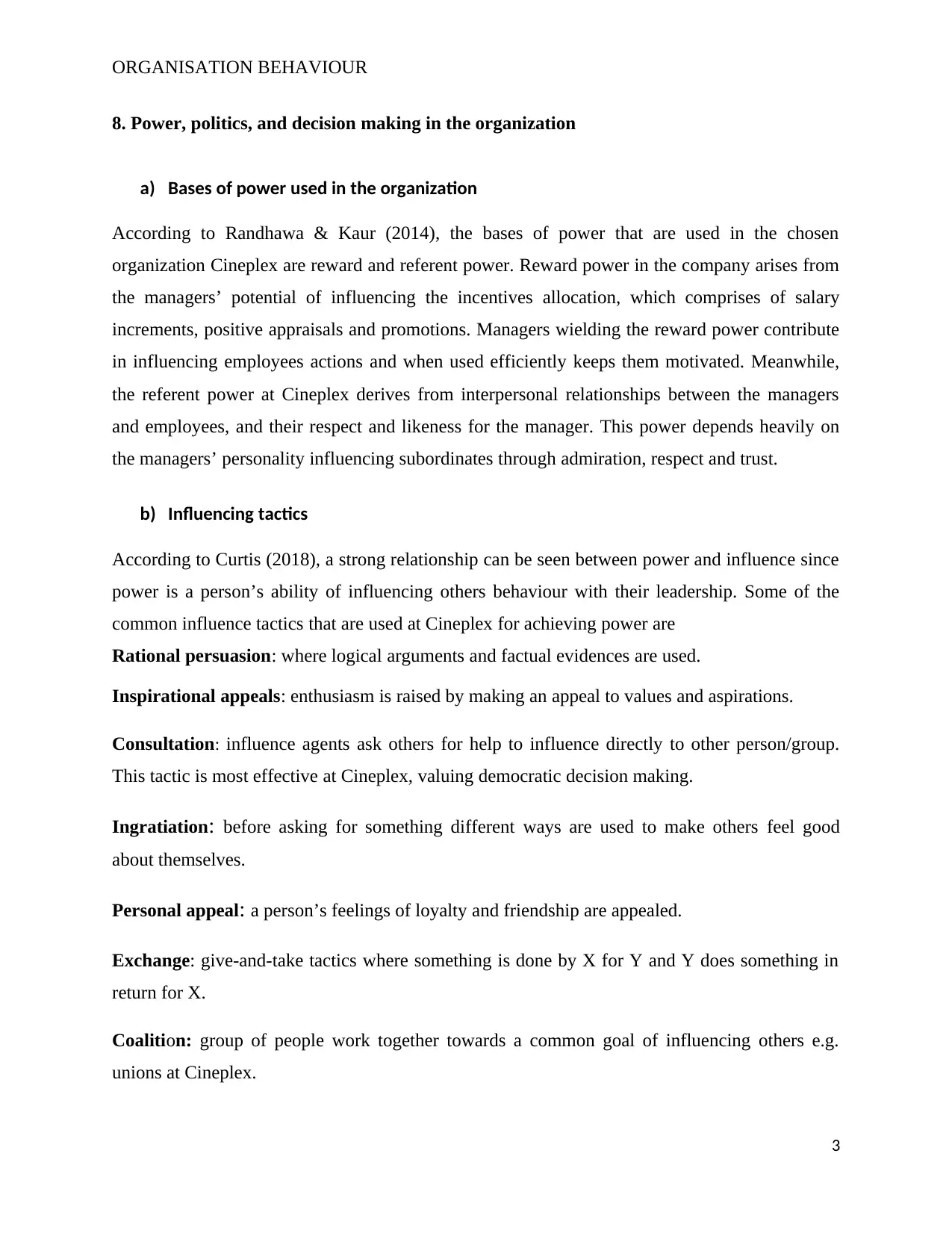
ORGANISATION BEHAVIOUR
8. Power, politics, and decision making in the organization
a) Bases of power used in the organization
According to Randhawa & Kaur (2014), the bases of power that are used in the chosen
organization Cineplex are reward and referent power. Reward power in the company arises from
the managers’ potential of influencing the incentives allocation, which comprises of salary
increments, positive appraisals and promotions. Managers wielding the reward power contribute
in influencing employees actions and when used efficiently keeps them motivated. Meanwhile,
the referent power at Cineplex derives from interpersonal relationships between the managers
and employees, and their respect and likeness for the manager. This power depends heavily on
the managers’ personality influencing subordinates through admiration, respect and trust.
b) Influencing tactics
According to Curtis (2018), a strong relationship can be seen between power and influence since
power is a person’s ability of influencing others behaviour with their leadership. Some of the
common influence tactics that are used at Cineplex for achieving power are
Rational persuasion: where logical arguments and factual evidences are used.
Inspirational appeals: enthusiasm is raised by making an appeal to values and aspirations.
Consultation: influence agents ask others for help to influence directly to other person/group.
This tactic is most effective at Cineplex, valuing democratic decision making.
Ingratiation: before asking for something different ways are used to make others feel good
about themselves.
Personal appeal: a person’s feelings of loyalty and friendship are appealed.
Exchange: give-and-take tactics where something is done by X for Y and Y does something in
return for X.
Coalition: group of people work together towards a common goal of influencing others e.g.
unions at Cineplex.
3
8. Power, politics, and decision making in the organization
a) Bases of power used in the organization
According to Randhawa & Kaur (2014), the bases of power that are used in the chosen
organization Cineplex are reward and referent power. Reward power in the company arises from
the managers’ potential of influencing the incentives allocation, which comprises of salary
increments, positive appraisals and promotions. Managers wielding the reward power contribute
in influencing employees actions and when used efficiently keeps them motivated. Meanwhile,
the referent power at Cineplex derives from interpersonal relationships between the managers
and employees, and their respect and likeness for the manager. This power depends heavily on
the managers’ personality influencing subordinates through admiration, respect and trust.
b) Influencing tactics
According to Curtis (2018), a strong relationship can be seen between power and influence since
power is a person’s ability of influencing others behaviour with their leadership. Some of the
common influence tactics that are used at Cineplex for achieving power are
Rational persuasion: where logical arguments and factual evidences are used.
Inspirational appeals: enthusiasm is raised by making an appeal to values and aspirations.
Consultation: influence agents ask others for help to influence directly to other person/group.
This tactic is most effective at Cineplex, valuing democratic decision making.
Ingratiation: before asking for something different ways are used to make others feel good
about themselves.
Personal appeal: a person’s feelings of loyalty and friendship are appealed.
Exchange: give-and-take tactics where something is done by X for Y and Y does something in
return for X.
Coalition: group of people work together towards a common goal of influencing others e.g.
unions at Cineplex.
3
⊘ This is a preview!⊘
Do you want full access?
Subscribe today to unlock all pages.

Trusted by 1+ million students worldwide
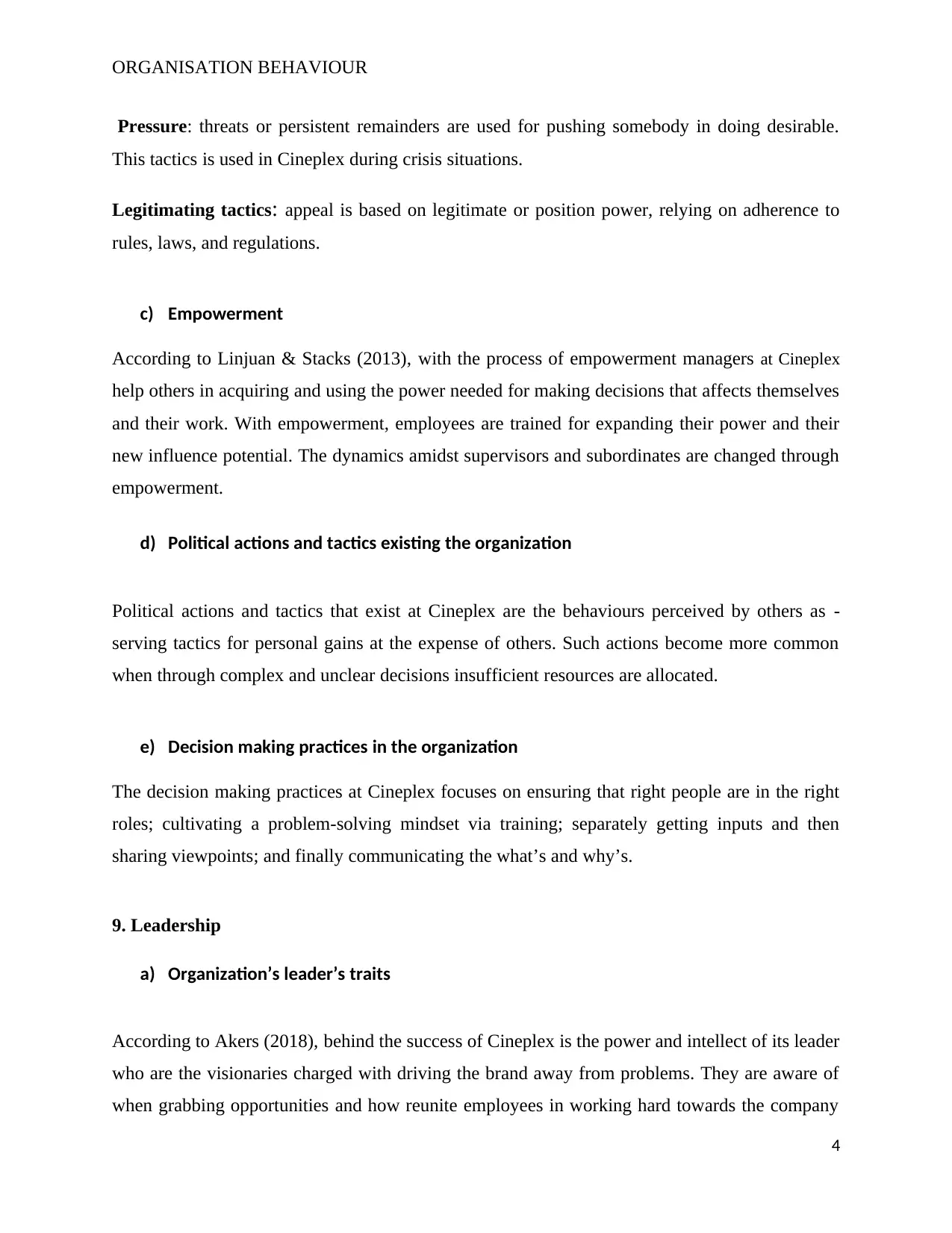
ORGANISATION BEHAVIOUR
Pressure: threats or persistent remainders are used for pushing somebody in doing desirable.
This tactics is used in Cineplex during crisis situations.
Legitimating tactics: appeal is based on legitimate or position power, relying on adherence to
rules, laws, and regulations.
c) Empowerment
According to Linjuan & Stacks (2013), with the process of empowerment managers at Cineplex
help others in acquiring and using the power needed for making decisions that affects themselves
and their work. With empowerment, employees are trained for expanding their power and their
new influence potential. The dynamics amidst supervisors and subordinates are changed through
empowerment.
d) Political actions and tactics existing the organization
Political actions and tactics that exist at Cineplex are the behaviours perceived by others as -
serving tactics for personal gains at the expense of others. Such actions become more common
when through complex and unclear decisions insufficient resources are allocated.
e) Decision making practices in the organization
The decision making practices at Cineplex focuses on ensuring that right people are in the right
roles; cultivating a problem-solving mindset via training; separately getting inputs and then
sharing viewpoints; and finally communicating the what’s and why’s.
9. Leadership
a) Organization’s leader’s traits
According to Akers (2018), behind the success of Cineplex is the power and intellect of its leader
who are the visionaries charged with driving the brand away from problems. They are aware of
when grabbing opportunities and how reunite employees in working hard towards the company
4
Pressure: threats or persistent remainders are used for pushing somebody in doing desirable.
This tactics is used in Cineplex during crisis situations.
Legitimating tactics: appeal is based on legitimate or position power, relying on adherence to
rules, laws, and regulations.
c) Empowerment
According to Linjuan & Stacks (2013), with the process of empowerment managers at Cineplex
help others in acquiring and using the power needed for making decisions that affects themselves
and their work. With empowerment, employees are trained for expanding their power and their
new influence potential. The dynamics amidst supervisors and subordinates are changed through
empowerment.
d) Political actions and tactics existing the organization
Political actions and tactics that exist at Cineplex are the behaviours perceived by others as -
serving tactics for personal gains at the expense of others. Such actions become more common
when through complex and unclear decisions insufficient resources are allocated.
e) Decision making practices in the organization
The decision making practices at Cineplex focuses on ensuring that right people are in the right
roles; cultivating a problem-solving mindset via training; separately getting inputs and then
sharing viewpoints; and finally communicating the what’s and why’s.
9. Leadership
a) Organization’s leader’s traits
According to Akers (2018), behind the success of Cineplex is the power and intellect of its leader
who are the visionaries charged with driving the brand away from problems. They are aware of
when grabbing opportunities and how reunite employees in working hard towards the company
4
Paraphrase This Document
Need a fresh take? Get an instant paraphrase of this document with our AI Paraphraser
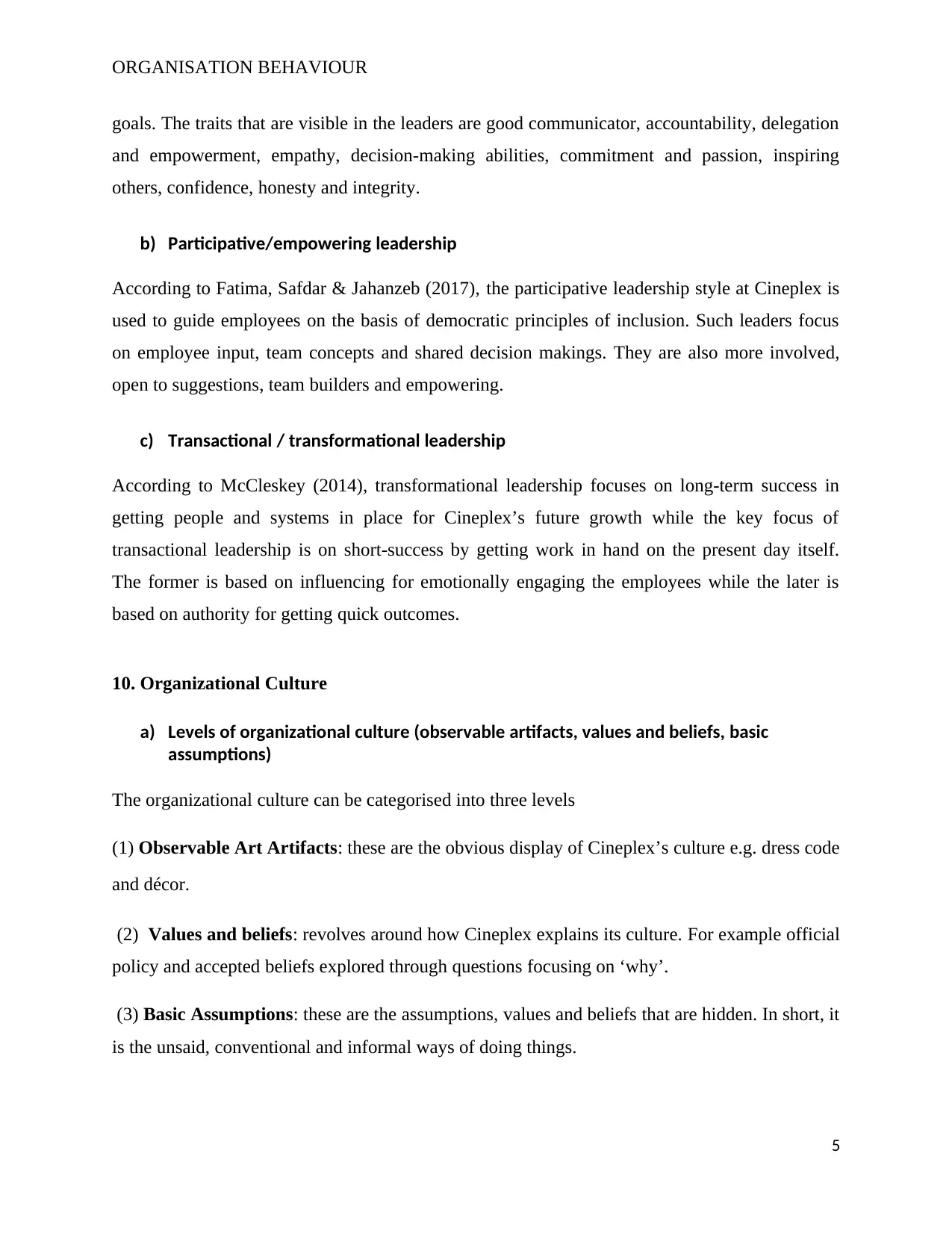
ORGANISATION BEHAVIOUR
goals. The traits that are visible in the leaders are good communicator, accountability, delegation
and empowerment, empathy, decision-making abilities, commitment and passion, inspiring
others, confidence, honesty and integrity.
b) Participative/empowering leadership
According to Fatima, Safdar & Jahanzeb (2017), the participative leadership style at Cineplex is
used to guide employees on the basis of democratic principles of inclusion. Such leaders focus
on employee input, team concepts and shared decision makings. They are also more involved,
open to suggestions, team builders and empowering.
c) Transactional / transformational leadership
According to McCleskey (2014), transformational leadership focuses on long-term success in
getting people and systems in place for Cineplex’s future growth while the key focus of
transactional leadership is on short-success by getting work in hand on the present day itself.
The former is based on influencing for emotionally engaging the employees while the later is
based on authority for getting quick outcomes.
10. Organizational Culture
a) Levels of organizational culture (observable artifacts, values and beliefs, basic
assumptions)
The organizational culture can be categorised into three levels
(1) Observable Art Artifacts: these are the obvious display of Cineplex’s culture e.g. dress code
and décor.
(2) Values and beliefs: revolves around how Cineplex explains its culture. For example official
policy and accepted beliefs explored through questions focusing on ‘why’.
(3) Basic Assumptions: these are the assumptions, values and beliefs that are hidden. In short, it
is the unsaid, conventional and informal ways of doing things.
5
goals. The traits that are visible in the leaders are good communicator, accountability, delegation
and empowerment, empathy, decision-making abilities, commitment and passion, inspiring
others, confidence, honesty and integrity.
b) Participative/empowering leadership
According to Fatima, Safdar & Jahanzeb (2017), the participative leadership style at Cineplex is
used to guide employees on the basis of democratic principles of inclusion. Such leaders focus
on employee input, team concepts and shared decision makings. They are also more involved,
open to suggestions, team builders and empowering.
c) Transactional / transformational leadership
According to McCleskey (2014), transformational leadership focuses on long-term success in
getting people and systems in place for Cineplex’s future growth while the key focus of
transactional leadership is on short-success by getting work in hand on the present day itself.
The former is based on influencing for emotionally engaging the employees while the later is
based on authority for getting quick outcomes.
10. Organizational Culture
a) Levels of organizational culture (observable artifacts, values and beliefs, basic
assumptions)
The organizational culture can be categorised into three levels
(1) Observable Art Artifacts: these are the obvious display of Cineplex’s culture e.g. dress code
and décor.
(2) Values and beliefs: revolves around how Cineplex explains its culture. For example official
policy and accepted beliefs explored through questions focusing on ‘why’.
(3) Basic Assumptions: these are the assumptions, values and beliefs that are hidden. In short, it
is the unsaid, conventional and informal ways of doing things.
5
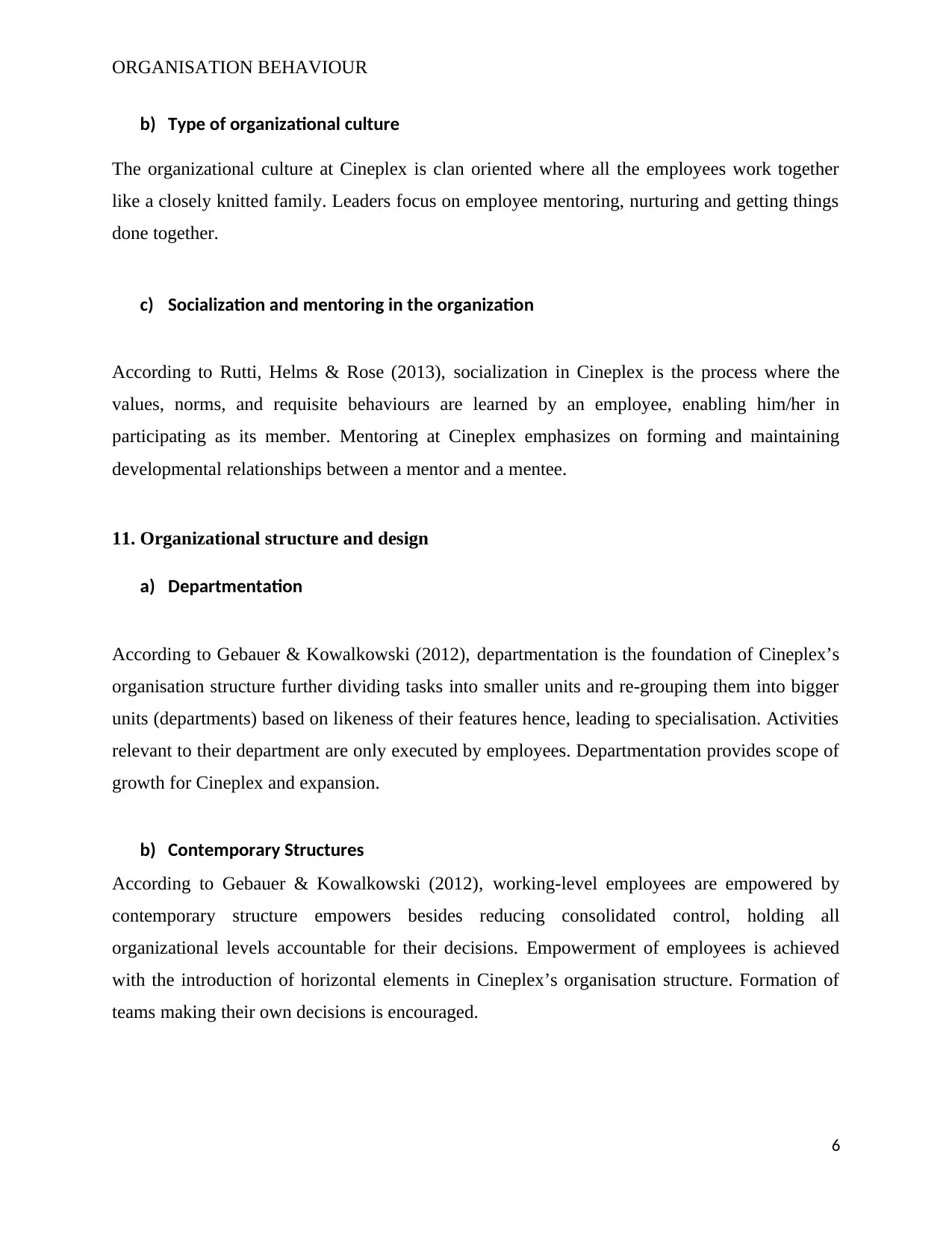
ORGANISATION BEHAVIOUR
b) Type of organizational culture
The organizational culture at Cineplex is clan oriented where all the employees work together
like a closely knitted family. Leaders focus on employee mentoring, nurturing and getting things
done together.
c) Socialization and mentoring in the organization
According to Rutti, Helms & Rose (2013), socialization in Cineplex is the process where the
values, norms, and requisite behaviours are learned by an employee, enabling him/her in
participating as its member. Mentoring at Cineplex emphasizes on forming and maintaining
developmental relationships between a mentor and a mentee.
11. Organizational structure and design
a) Departmentation
According to Gebauer & Kowalkowski (2012), departmentation is the foundation of Cineplex’s
organisation structure further dividing tasks into smaller units and re-grouping them into bigger
units (departments) based on likeness of their features hence, leading to specialisation. Activities
relevant to their department are only executed by employees. Departmentation provides scope of
growth for Cineplex and expansion.
b) Contemporary Structures
According to Gebauer & Kowalkowski (2012), working-level employees are empowered by
contemporary structure empowers besides reducing consolidated control, holding all
organizational levels accountable for their decisions. Empowerment of employees is achieved
with the introduction of horizontal elements in Cineplex’s organisation structure. Formation of
teams making their own decisions is encouraged.
6
b) Type of organizational culture
The organizational culture at Cineplex is clan oriented where all the employees work together
like a closely knitted family. Leaders focus on employee mentoring, nurturing and getting things
done together.
c) Socialization and mentoring in the organization
According to Rutti, Helms & Rose (2013), socialization in Cineplex is the process where the
values, norms, and requisite behaviours are learned by an employee, enabling him/her in
participating as its member. Mentoring at Cineplex emphasizes on forming and maintaining
developmental relationships between a mentor and a mentee.
11. Organizational structure and design
a) Departmentation
According to Gebauer & Kowalkowski (2012), departmentation is the foundation of Cineplex’s
organisation structure further dividing tasks into smaller units and re-grouping them into bigger
units (departments) based on likeness of their features hence, leading to specialisation. Activities
relevant to their department are only executed by employees. Departmentation provides scope of
growth for Cineplex and expansion.
b) Contemporary Structures
According to Gebauer & Kowalkowski (2012), working-level employees are empowered by
contemporary structure empowers besides reducing consolidated control, holding all
organizational levels accountable for their decisions. Empowerment of employees is achieved
with the introduction of horizontal elements in Cineplex’s organisation structure. Formation of
teams making their own decisions is encouraged.
6
⊘ This is a preview!⊘
Do you want full access?
Subscribe today to unlock all pages.

Trusted by 1+ million students worldwide
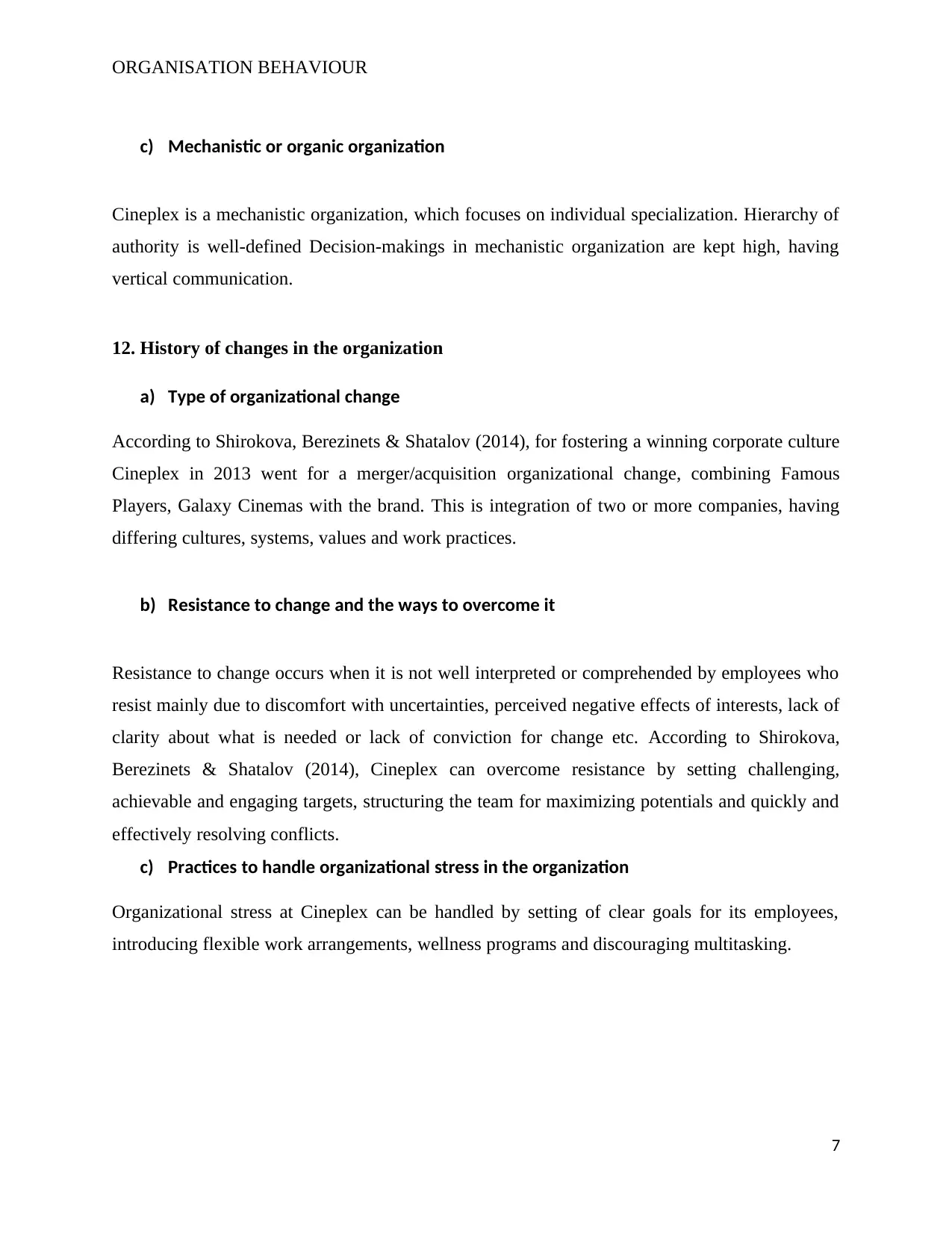
ORGANISATION BEHAVIOUR
c) Mechanistic or organic organization
Cineplex is a mechanistic organization, which focuses on individual specialization. Hierarchy of
authority is well-defined Decision-makings in mechanistic organization are kept high, having
vertical communication.
12. History of changes in the organization
a) Type of organizational change
According to Shirokova, Berezinets & Shatalov (2014), for fostering a winning corporate culture
Cineplex in 2013 went for a merger/acquisition organizational change, combining Famous
Players, Galaxy Cinemas with the brand. This is integration of two or more companies, having
differing cultures, systems, values and work practices.
b) Resistance to change and the ways to overcome it
Resistance to change occurs when it is not well interpreted or comprehended by employees who
resist mainly due to discomfort with uncertainties, perceived negative effects of interests, lack of
clarity about what is needed or lack of conviction for change etc. According to Shirokova,
Berezinets & Shatalov (2014), Cineplex can overcome resistance by setting challenging,
achievable and engaging targets, structuring the team for maximizing potentials and quickly and
effectively resolving conflicts.
c) Practices to handle organizational stress in the organization
Organizational stress at Cineplex can be handled by setting of clear goals for its employees,
introducing flexible work arrangements, wellness programs and discouraging multitasking.
7
c) Mechanistic or organic organization
Cineplex is a mechanistic organization, which focuses on individual specialization. Hierarchy of
authority is well-defined Decision-makings in mechanistic organization are kept high, having
vertical communication.
12. History of changes in the organization
a) Type of organizational change
According to Shirokova, Berezinets & Shatalov (2014), for fostering a winning corporate culture
Cineplex in 2013 went for a merger/acquisition organizational change, combining Famous
Players, Galaxy Cinemas with the brand. This is integration of two or more companies, having
differing cultures, systems, values and work practices.
b) Resistance to change and the ways to overcome it
Resistance to change occurs when it is not well interpreted or comprehended by employees who
resist mainly due to discomfort with uncertainties, perceived negative effects of interests, lack of
clarity about what is needed or lack of conviction for change etc. According to Shirokova,
Berezinets & Shatalov (2014), Cineplex can overcome resistance by setting challenging,
achievable and engaging targets, structuring the team for maximizing potentials and quickly and
effectively resolving conflicts.
c) Practices to handle organizational stress in the organization
Organizational stress at Cineplex can be handled by setting of clear goals for its employees,
introducing flexible work arrangements, wellness programs and discouraging multitasking.
7
Paraphrase This Document
Need a fresh take? Get an instant paraphrase of this document with our AI Paraphraser
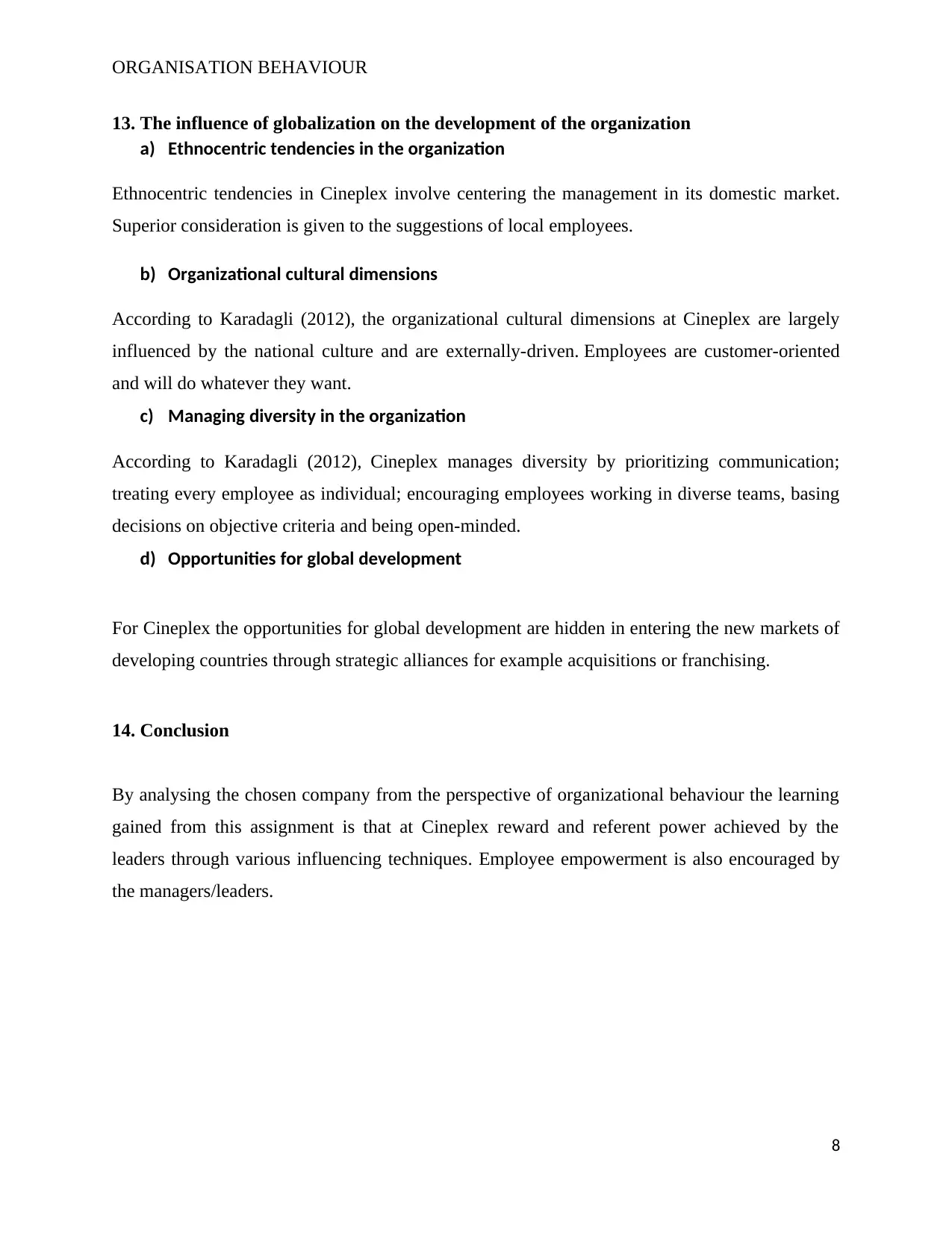
ORGANISATION BEHAVIOUR
13. The influence of globalization on the development of the organization
a) Ethnocentric tendencies in the organization
Ethnocentric tendencies in Cineplex involve centering the management in its domestic market.
Superior consideration is given to the suggestions of local employees.
b) Organizational cultural dimensions
According to Karadagli (2012), the organizational cultural dimensions at Cineplex are largely
influenced by the national culture and are externally-driven. Employees are customer-oriented
and will do whatever they want.
c) Managing diversity in the organization
According to Karadagli (2012), Cineplex manages diversity by prioritizing communication;
treating every employee as individual; encouraging employees working in diverse teams, basing
decisions on objective criteria and being open-minded.
d) Opportunities for global development
For Cineplex the opportunities for global development are hidden in entering the new markets of
developing countries through strategic alliances for example acquisitions or franchising.
14. Conclusion
By analysing the chosen company from the perspective of organizational behaviour the learning
gained from this assignment is that at Cineplex reward and referent power achieved by the
leaders through various influencing techniques. Employee empowerment is also encouraged by
the managers/leaders.
8
13. The influence of globalization on the development of the organization
a) Ethnocentric tendencies in the organization
Ethnocentric tendencies in Cineplex involve centering the management in its domestic market.
Superior consideration is given to the suggestions of local employees.
b) Organizational cultural dimensions
According to Karadagli (2012), the organizational cultural dimensions at Cineplex are largely
influenced by the national culture and are externally-driven. Employees are customer-oriented
and will do whatever they want.
c) Managing diversity in the organization
According to Karadagli (2012), Cineplex manages diversity by prioritizing communication;
treating every employee as individual; encouraging employees working in diverse teams, basing
decisions on objective criteria and being open-minded.
d) Opportunities for global development
For Cineplex the opportunities for global development are hidden in entering the new markets of
developing countries through strategic alliances for example acquisitions or franchising.
14. Conclusion
By analysing the chosen company from the perspective of organizational behaviour the learning
gained from this assignment is that at Cineplex reward and referent power achieved by the
leaders through various influencing techniques. Employee empowerment is also encouraged by
the managers/leaders.
8
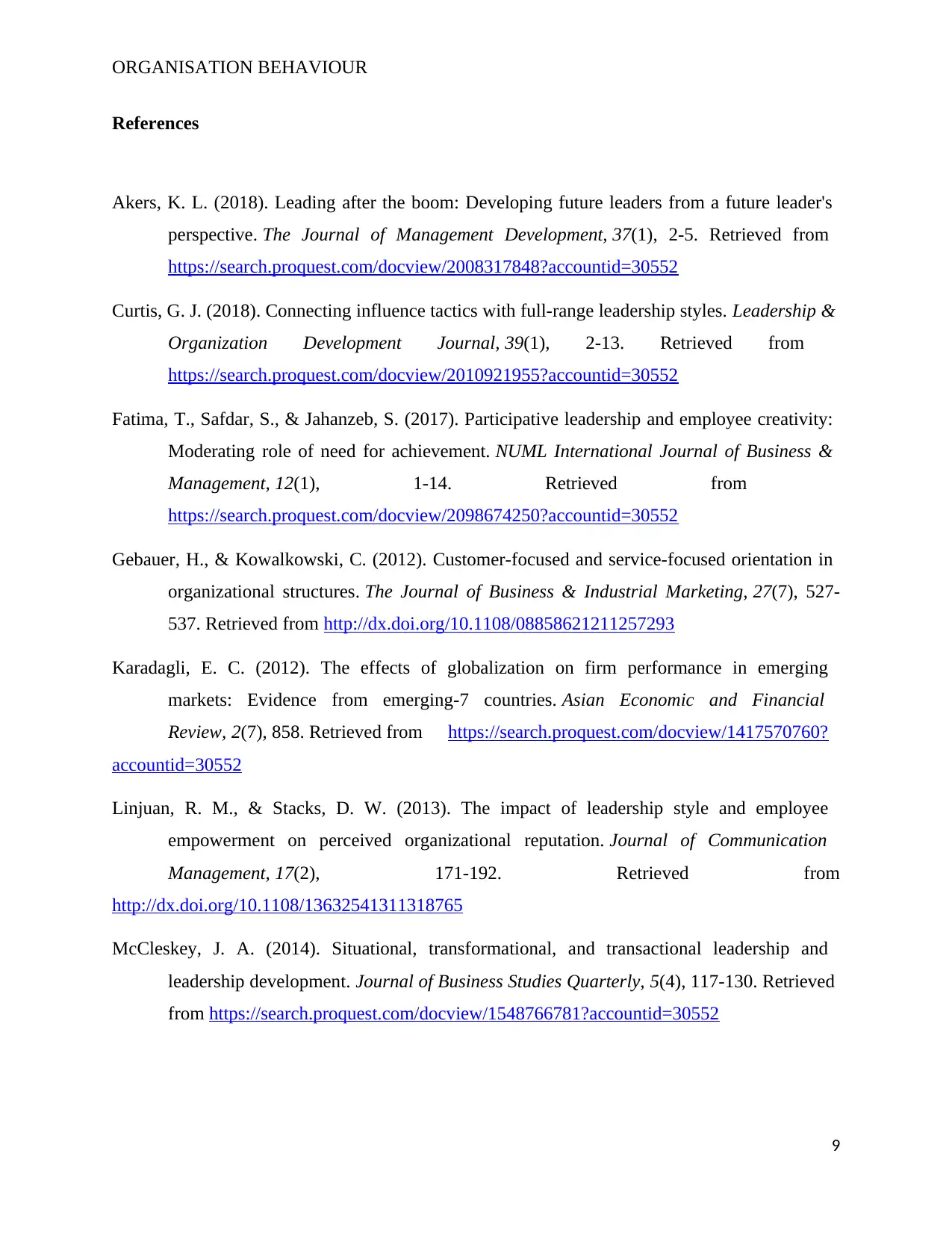
ORGANISATION BEHAVIOUR
References
Akers, K. L. (2018). Leading after the boom: Developing future leaders from a future leader's
perspective. The Journal of Management Development, 37(1), 2-5. Retrieved from
https://search.proquest.com/docview/2008317848?accountid=30552
Curtis, G. J. (2018). Connecting influence tactics with full-range leadership styles. Leadership &
Organization Development Journal, 39(1), 2-13. Retrieved from
https://search.proquest.com/docview/2010921955?accountid=30552
Fatima, T., Safdar, S., & Jahanzeb, S. (2017). Participative leadership and employee creativity:
Moderating role of need for achievement. NUML International Journal of Business &
Management, 12(1), 1-14. Retrieved from
https://search.proquest.com/docview/2098674250?accountid=30552
Gebauer, H., & Kowalkowski, C. (2012). Customer-focused and service-focused orientation in
organizational structures. The Journal of Business & Industrial Marketing, 27(7), 527-
537. Retrieved from http://dx.doi.org/10.1108/08858621211257293
Karadagli, E. C. (2012). The effects of globalization on firm performance in emerging
markets: Evidence from emerging-7 countries. Asian Economic and Financial
Review, 2(7), 858. Retrieved from https://search.proquest.com/docview/1417570760?
accountid=30552
Linjuan, R. M., & Stacks, D. W. (2013). The impact of leadership style and employee
empowerment on perceived organizational reputation. Journal of Communication
Management, 17(2), 171-192. Retrieved from
http://dx.doi.org/10.1108/13632541311318765
McCleskey, J. A. (2014). Situational, transformational, and transactional leadership and
leadership development. Journal of Business Studies Quarterly, 5(4), 117-130. Retrieved
from https://search.proquest.com/docview/1548766781?accountid=30552
9
References
Akers, K. L. (2018). Leading after the boom: Developing future leaders from a future leader's
perspective. The Journal of Management Development, 37(1), 2-5. Retrieved from
https://search.proquest.com/docview/2008317848?accountid=30552
Curtis, G. J. (2018). Connecting influence tactics with full-range leadership styles. Leadership &
Organization Development Journal, 39(1), 2-13. Retrieved from
https://search.proquest.com/docview/2010921955?accountid=30552
Fatima, T., Safdar, S., & Jahanzeb, S. (2017). Participative leadership and employee creativity:
Moderating role of need for achievement. NUML International Journal of Business &
Management, 12(1), 1-14. Retrieved from
https://search.proquest.com/docview/2098674250?accountid=30552
Gebauer, H., & Kowalkowski, C. (2012). Customer-focused and service-focused orientation in
organizational structures. The Journal of Business & Industrial Marketing, 27(7), 527-
537. Retrieved from http://dx.doi.org/10.1108/08858621211257293
Karadagli, E. C. (2012). The effects of globalization on firm performance in emerging
markets: Evidence from emerging-7 countries. Asian Economic and Financial
Review, 2(7), 858. Retrieved from https://search.proquest.com/docview/1417570760?
accountid=30552
Linjuan, R. M., & Stacks, D. W. (2013). The impact of leadership style and employee
empowerment on perceived organizational reputation. Journal of Communication
Management, 17(2), 171-192. Retrieved from
http://dx.doi.org/10.1108/13632541311318765
McCleskey, J. A. (2014). Situational, transformational, and transactional leadership and
leadership development. Journal of Business Studies Quarterly, 5(4), 117-130. Retrieved
from https://search.proquest.com/docview/1548766781?accountid=30552
9
⊘ This is a preview!⊘
Do you want full access?
Subscribe today to unlock all pages.

Trusted by 1+ million students worldwide
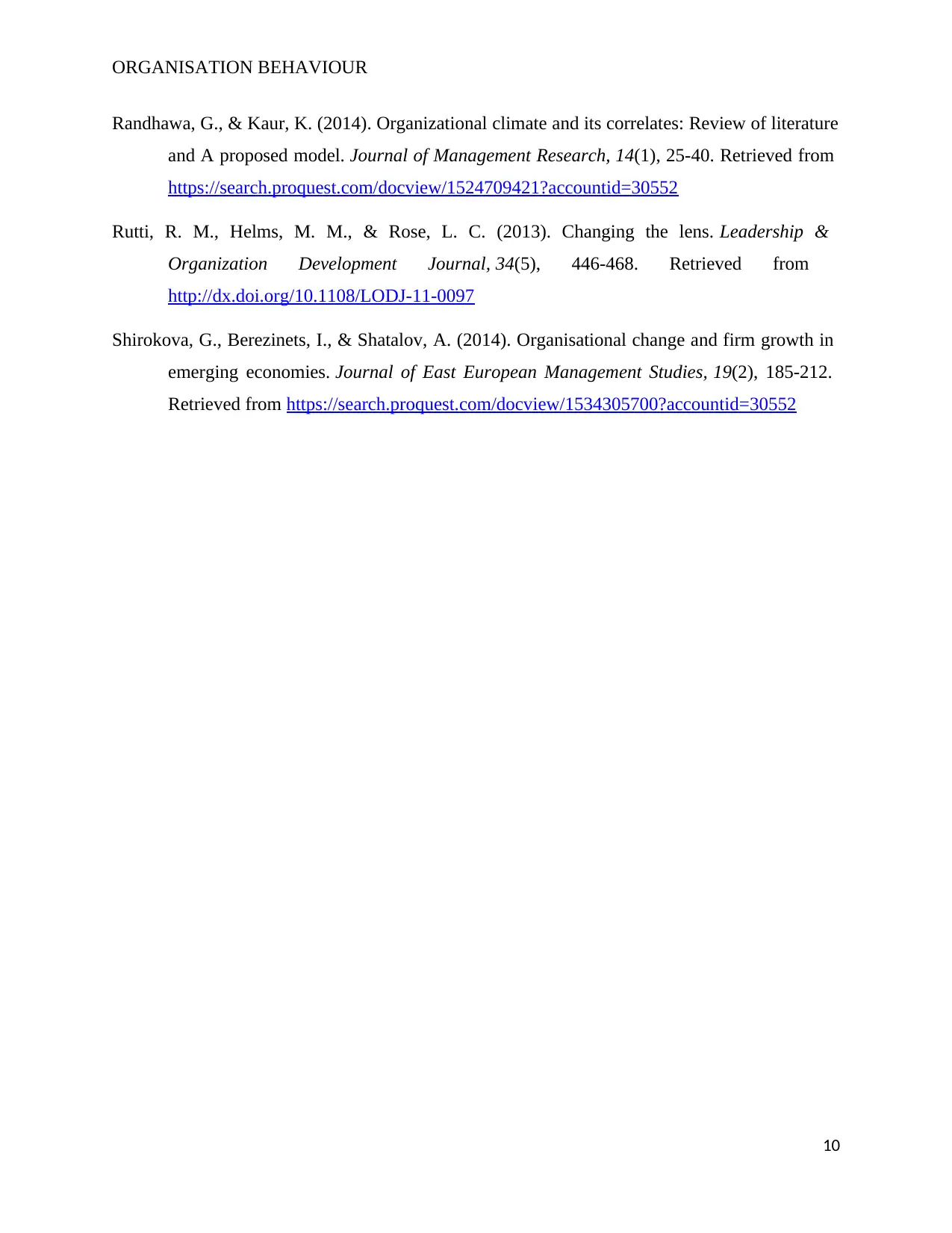
ORGANISATION BEHAVIOUR
Randhawa, G., & Kaur, K. (2014). Organizational climate and its correlates: Review of literature
and A proposed model. Journal of Management Research, 14(1), 25-40. Retrieved from
https://search.proquest.com/docview/1524709421?accountid=30552
Rutti, R. M., Helms, M. M., & Rose, L. C. (2013). Changing the lens. Leadership &
Organization Development Journal, 34(5), 446-468. Retrieved from
http://dx.doi.org/10.1108/LODJ-11-0097
Shirokova, G., Berezinets, I., & Shatalov, A. (2014). Organisational change and firm growth in
emerging economies. Journal of East European Management Studies, 19(2), 185-212.
Retrieved from https://search.proquest.com/docview/1534305700?accountid=30552
10
Randhawa, G., & Kaur, K. (2014). Organizational climate and its correlates: Review of literature
and A proposed model. Journal of Management Research, 14(1), 25-40. Retrieved from
https://search.proquest.com/docview/1524709421?accountid=30552
Rutti, R. M., Helms, M. M., & Rose, L. C. (2013). Changing the lens. Leadership &
Organization Development Journal, 34(5), 446-468. Retrieved from
http://dx.doi.org/10.1108/LODJ-11-0097
Shirokova, G., Berezinets, I., & Shatalov, A. (2014). Organisational change and firm growth in
emerging economies. Journal of East European Management Studies, 19(2), 185-212.
Retrieved from https://search.proquest.com/docview/1534305700?accountid=30552
10
1 out of 10
Related Documents
Your All-in-One AI-Powered Toolkit for Academic Success.
+13062052269
info@desklib.com
Available 24*7 on WhatsApp / Email
![[object Object]](/_next/static/media/star-bottom.7253800d.svg)
Unlock your academic potential
Copyright © 2020–2025 A2Z Services. All Rights Reserved. Developed and managed by ZUCOL.





